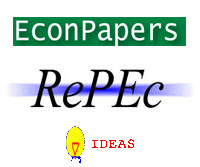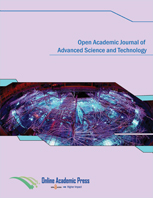Instructions for Authors
1. Submission Checklist
Please:
- Read the Aims & Scope to gain an overview and assess if your manuscript is suitable for this journal;
- Use Microsoft Word to prepare your manuscript;
- Make sure that issues about publication ethics, copyright, authorship, figure formats, and data/reference format have been appropriately considered;
- Ensure that all authors have approved the content of the submitted manuscript.
2. Manuscript Submission Overview
2.1. Types of Publications
Open Academic Journal of Advanced Science and Technology has no restrictions on the length of manuscripts, provided that the text is concise and comprehensive. Full details of the methods used to conduct the research must be provided so that the results can be reproduced.
Manuscripts submitted to Open Academic Journal of Advanced Science and Technology will neither be published previously nor be under consideration for publication in another journal. The main article types are as follows:
- Articles: Original research manuscripts. The journal considers all original research manuscripts in which the research itself was conducted using scientifically sound experiments and provides a substantial amount of new information. Authors should not unnecessarily divide their work into several related manuscripts, although short Communications of preliminary, but significant, results will be considered. The peer-review process will assess the quality and scientific impact of the study to ensure relevance and importance.
- Reviews: These provide concise updates on the latest progress made in a given area of research. Systematic reviews should follow the PRISMA guidelines. PRISMA covers systematic reviews and meta-analyses. Authors are recommended to complete the checklist and flow diagram and include it with their submission.
2.2. Submission Process
Manuscripts for Open Academic Journal of Advanced Science and Technology should be submitted online OR email attachment at editor@onlineacademicpress.com. The submitting author or corresponding author is responsible for the manuscript during the submission and peer-review process and must ensure that all eligible co-authors have been included in the author list (read the criteria to qualify for authorship) and that they have all read and approved the submitted version of the manuscript.
2.3. Accepted File Format
Authors are encouraged to use Microsoft Word to prepare their manuscript. Using the template file will substantially shorten the time to complete copy-editing and publication of accepted manuscripts.
2.4. Free Format Submission
Open Academic Journal of Advanced Science and Technology now accepts free format submission:
- We do not have strict formatting requirements, but advise that all manuscripts must contain the required sections: Author Information, Abstract, Keywords, Introduction, Materials & Methods, Results, Conclusions, Figures and Tables with Captions, Funding Information, and Conflict of Interest and other Ethics Statements.
- Your references may be in any style, provided that formatting is consistent and correct throughout. It is essential to include author(s) name(s), journal or book title, article or chapter title (where required), year of publication, volume and issue (where appropriate), and pagination. DOI numbers (Digital Object Identifier) are not mandatory but highly encouraged. The bibliography software packages EndNote, Zotero, Mendeley, and Reference Manager are also recommended.
- Should your manuscript be accepted, the formatting will be handled by our editorial office.
2.5. Cover Letter
A cover letter must be included with each manuscript submission and should contain the full names of all associated authors and affiliations, and further details about identifying text removed from the manuscript; you may append the complete version of your manuscript to the cover letter. It should also be concise and explain the scientific significance of the research, comparing the findings of the work with that of existing work and why the paper fits the scope of the journal. You will confirm that neither the manuscript nor any parts of its content are currently under consideration or published in another journal, and any prior submissions of the manuscript to Open Academic Journal of Advanced Science and Technology must be acknowledged.
3. Manuscript Preparation
3.1. General Considerations
- Research manuscripts should comprise:
- Front matter: Title, Author list, Affiliations, Abstract, Keywords
- Research manuscript sections: Introduction, Methodology, Materials and Methods, Results, Discussion, and Conclusions (optional).
- Back matter: Supplementary Materials, Acknowledgments, Conflicts of Interest, References.
- Review manuscripts: Structured reviews and meta-analyses should use the same structure as research articles and ensure they conform to the PRISMA guidelines.
- Acronyms/Abbreviations/Initialisms should be defined the first time they appear in each of three sections: the abstract; the main text; the first figure or table. When expressed in the first instance, the acronym/abbreviation/initialism should be added in parentheses after the written-out form.
- SI Units (International System of Units) should be used. Imperial, US customary, and other units should be converted to SI units whenever possible.
- Equations: If you are using Word, please use the Microsoft Equation Editor. Equations should be editable by the editorial office and should not appear in a picture format.
- Research Data and supplementary materials: Note that publication of your manuscript implies that you must make all materials, data, and protocols associated with the publication available to readers. Disclose at the submission stage any restrictions on the availability of materials or information.
3.2. Front Matter
These sections should appear in all manuscript types
- Title: The title of your manuscript should be concise, specific, and relevant. It should identify if the study reports (human or animal) trial data, or if the study is a systematic review, meta-analysis, or replication study. Please do not include abbreviations or other shortening of words, as well as running title or heads. These will be removed by our Editorial Office.
- Author List and Affiliations: Authors' first and last names must be provided. Initials of any middle names can be added at the writer’s/author’s discretion. The PubMed/MEDLINE standard format is used for affiliations: complete address information including city, zip code, state/province, and country. At least one author should be designated as the corresponding author, and his or her email address and other details should be included at the end of the affiliation section. Please read the criteria to qualify for authorship.
- Abstract: The abstract should be an objective representation of the article and should be no more than around 200 words and should be a single paragraph that follows a structure as follows: 1) Background: Place the question addressed in a broad context and highlight the purpose of the study. 2) Methods: Describe briefly the main methods or treatments applied and include any relevant preregistration numbers, species, and strains of any animals used. 3) Results: Summarize the article's main findings. 4) Conclusion: provide a brief summary of the main conclusions or interpretations. The abstract must not contain results that are not presented and substantiated in the main text and should not exaggerate the main conclusions.
- Keywords: Three to ten pertinent keywords need to be added after the abstract. We recommend that the keywords are specific to the article, yet reasonably common within the subject discipline.
3.3. Research Manuscript Sections
- Introduction: The introduction should be comprehensible to scientists working outside the topic of the paper and should briefly place the study in a broad but relevant context and highlight the reasons for its necessity and importance. The purpose of the work, including its significance and aims, as well as including specific hypotheses being exercised, should be clearly detailed. The current state of the research field should be reviewed carefully and key publications cited, and controversial and diverging hypotheses should be discussed when necessary. Finally, the main aim of the work and the conclusion of the study should be briefly detailed.
- Materials and Methods: These should be described with sufficient detail to allow others to replicate and build on published results. While well-established methods can be briefly described and appropriately cited, new methods and protocols should be described in detail. Name and versions of any software used should be provided and make clear whether computer code used is available. Include any pre-registration codes.
- Results: Provide a concise and precise description of the experimental results, their interpretation as well as the experimental conclusions that can be drawn.
- Discussion: This section may be combined with the Results section, however, authors should discuss the results and how they can be interpreted in respect of previous studies and of the working hypotheses in the current study. The findings and their implications should be discussed in the broadest context possible and limitations of the work should be highlighted to allow for further interpretation and recommendation of future research, the directions of which may also be mentioned.
- Conclusions: This section is not mandatory but can be added to the manuscript if the discussion is unusually long or complex.
- Patents: This section is not mandatory but may be added if there are patents resulting from the work reported in this manuscript.
3.4. Back Matter
- Supplementary Materials: Describe any supplementary material published online alongside the manuscript (figure, tables, video, spreadsheets, etc.). Please indicate the name and title of each element as follows Figure S1: title, Table S1: title, etc.
- Funding: All sources of funding for the study should be fully disclosed, detailing grants that have been awarded in support of your research work and if funds were provided to cover publication costs. Note that some funders will not refund article processing charges (APC) if the funder and grant number are not clearly and correctly identified in the paper. Funding information can be entered separately into the submission system by the authors during submission of their manuscript. Such funding information, if available, will be deposited to FundRef if the manuscript is finally published.
Please add: “This research received no external funding” or “This research was funded by [name of funder] grant number [xxx]” and “The APC was funded by [XXX]” in this section, and ensure that the details given are accurate and use the standard spelling of funding agency names at https://search.crossref.org/funding, as any errors may affect your future funding. - Acknowledgments: In this section, you can acknowledge any support given which is not covered by the author contribution or funding sections. This may include administrative and technical support, or donations in kind (e.g., materials used for experiments).
- Conflicts of Interest: Authors must identify and declare any personal circumstances or interests that may be perceived as influencing the representation or interpretation of reported research results. If there are no conflicts of interest, please state "The authors declare no conflict of interest”, however, it must be declared in this section if there is any role of the funding sponsors in the design of the study, collection, analyses, or data interpretation, writing of the manuscript, or in the decision to publish the results. If there is no role, please state “The funding sponsors had no role in the design of the study; in the collection, analyses, or interpretation of data; in the writing of the manuscript, and in the decision to publish the results”.
- References: A reference list will appear at the end of the paper and is always arranged alphabetically. All sources are listed by the last names of the authors and listed individually at the end of the manuscript. We recommend preparing the references with a bibliography software package, such as EndNote, ReferenceManager, or Zotero to avoid typing mistakes and duplicated references. They should be single-spaced and 10 pt font size. APA reference and citations format should be used. All references mentioned in the Reference List will be cited in the text, and vice versa.
3.5. Preparing Figures, Schemes, and Tables
- File for Figures and Schemes must be provided during submission in a single zip archive and at a sufficiently high resolution (minimum 1000 pixels width/height, or a resolution of 300 dpi or higher). Common formats are accepted, however, TIFF, JPEG, EPS, and PDF are encouraged.
- Please contact the Economies editorial office for further advice on publishing multimedia files in articles or as supplementary materials.
- All Figures, Schemes, and Tables should be inserted into the main text close to their first citation and must be numbered following their number of appearance (Figure 1, Scheme I, Figure 2, Scheme II, Table 1, etc.).
- All Figures, Schemes and Tables should have a short explanatory title and caption.
- All table columns should have an explanatory heading. To facilitate the copy-editing of larger tables, smaller fonts may be used, but no less than 8 pt. in size. Authors should use the Table option of Microsoft Word to create tables.
- Authors are encouraged to prepare figures and schemes in color (RGB at 8-bit per channel). There is no additional cost for publishing full-color graphics.
3.6. Citation Policy
Authors should ensure that where material is taken from other sources (including their own published writing), the source is clearly cited and that, where appropriate, permission is obtained from the relevant authors.
Authors should not engage in excessive self-citation and should not copy references from other publications if they have not read the cited work.
Authors should not preferentially cite their own or their friends’, peers’, or institution’s publications.
Authors should not cite advertisements or advertorial material.
In accordance with COPE guidelines, we expect that “original wording taken directly from publications by other researchers should appear in quotation marks with the appropriate citations.” This condition also applies to an author’s own work. COPE have produced a discussion document on citation manipulation with recommendations for best practice.




